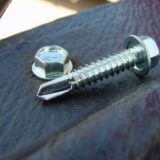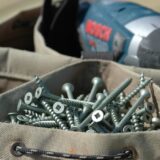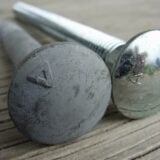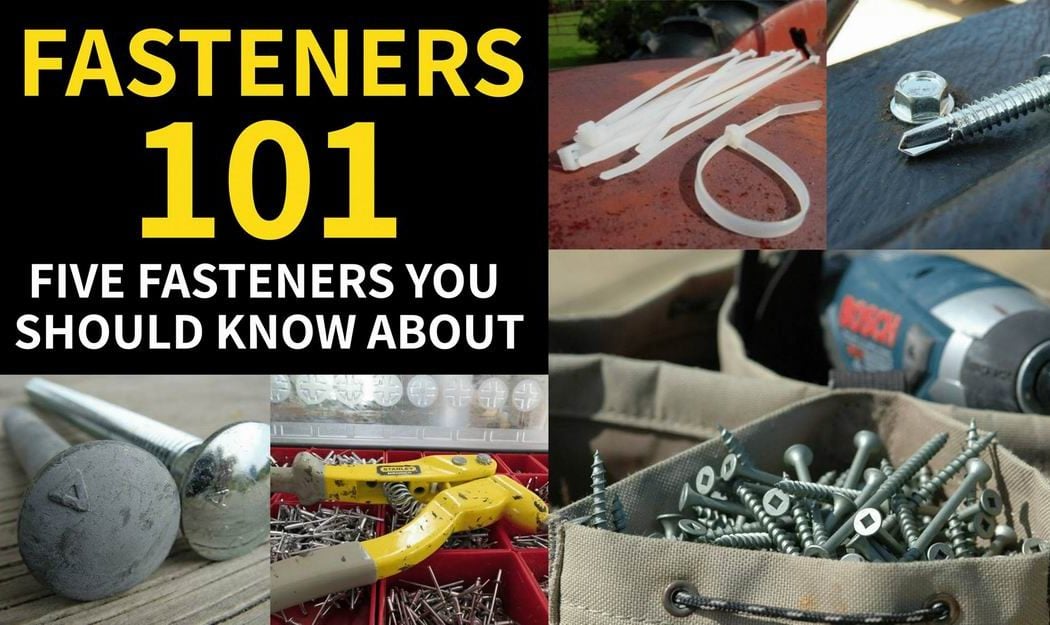There are hundreds of different kinds of fasteners in the world and you can safely forget about most of them for building and maintaining things around your home, but there are five fasteners you should know about because you’ll find them indispensable.
Effective do-it-yourself work depends on organizing yourself so it’s easy to succeed. And this means keeping essential fasteners on hand so you can get stuff done instead of fighting your way through a parking lot every time something at your place begins to unravel. Get a case or bag to keep things organized.
Self-drilling screws
 You may not need to screw things to plastic, hardwood or sheet metal every day, but when you do, these screws can’t be beat.
You may not need to screw things to plastic, hardwood or sheet metal every day, but when you do, these screws can’t be beat.
Sometimes called TEK screws after the brand that made them popular, they have a hex-shaped head at one end (something like a bolt), with a pointy tip at the other end that’s shaped like a drill bit.
Spin the fastener in a drill and it bores into most hard materials, creating just the right size hole for the screw to grip. Continue spinning until the screw tightens down.
Deck screws

Some deck screws are better than others. Today’s best screws include a serrated thread design. These cut their way into wood much more easily than ordinary wood screws. You can even drive them into hardwood without predrilling a starting hole first.
Deck screws are popular, and there’s a reason why. They’re a cheap, strong and excellent way to join wood. The best versions are highly corrosion resistant, too.
You should keep 1½-inch, 2-inch, 2½-inch, 3-inch, 3½-inch and 4-inch lengths on hand. Sounds excessive? It’s not when you realize that proper screw length is a big deal.
For most applications, screw threads should penetrate the underlying wood by at least one inch. More is better. But at the same time, long screws are a problem if it means that screw tips pop out the other side of your work. This is why you’ll appreciate lots of different lengths to choose from.
I store my inventory of screws in a couple of nylon “parachute bags”. This keeps everything in good order, yet also accessible for jobs ranging from a rooftop repair to a woodworking project.
Galvanized bolts & nails

These are different than the shiny, plated fasteners. Understanding the advantage of galvanizing is critical with today’s pressure treated lumber. The dull grey bolt head on the left is hot-dipped galvanized. The shiny bolt is rust-prone electroplated.
Got some outdoor construction to do? Hot-dipped galvanized bolts and nails are a minimum for exterior applications. They cost a bit more, but they’re definitely worth it because they won’t rust.
Will you be nailing pressure treated lumber? Today’s rot prevention chemicals are much more corrosive to metal fasteners than older formulations. Go with stainless-steel nails in pressure treated wood and you’ll be fine.
Plated nails and screws that are specifically rated for use with “ACQ” treated lumber won’t let you down, either. Just look for the approval sticker on the box.
You’ll find that 2½-inch and 3½-inch nails and screws can fasten almost anything you’re faced with outdoors.
Pop rivets

I don’t know why these aren’t more common. You’ll love pop rivets if you give them a try.
Put the pop rivet into the gun, squeeze the trigger, then the end of the rivet swells and locks. Pop rivets connect metal, leather and fabric in a neat and quick way.
Drill or punch a hole sized to accept the shank of the rivet you’re using, put a rivet in the installation gun, slip the rivet into the hole, then squeeze the gun handle until you hear a “pop”. This means that the rivet has swollen to full size and the joint is now locked. The operation takes just seconds.
Use washers under the heads of pop rivets when you’re joining cloth or leather.
Cable ties

Super useful for all kinds of binding and tying tasks, cable ties are small bands of plastic designed to bind wires, small tubes and bundles of things.
One end of the tie feeds into a slot in the other end and only goes one way. You can tighten a cable tie, but it won’t come apart again. They’re made of nylon and amazingly strong.
The best way to buy cable ties is as an assortment of sizes ranging from two inches to 10 inches in length.
For outdoor applications, choose black cable ties so they won’t break down in sunlight.






